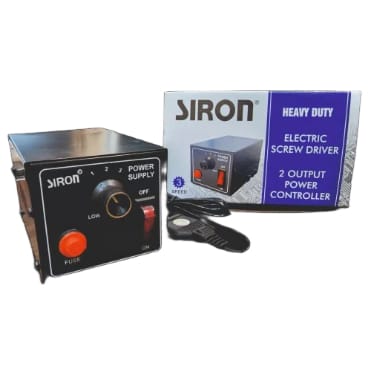1
/
of
1
SIRON Electric Screw Driver Power Supply Controller
SIRON Electric Screw Driver Power Supply Controller
Regular price
Rs. 450.00
Regular price
Rs. 500.00
Sale price
Rs. 450.00
Unit price
/
per
Taxes included.
Shipping calculated at checkout.
Couldn't load pickup availability
- Affordable Price
- Recycle
- Free Delivery
An Electric Screwdriver Power Driver is a handheld power tool designed to drive screws into various materials quickly and efficiently. It is a versatile tool used in construction, woodworking, electronics, automotive repair, and household tasks. Below is a full description of its features, components, and functionalities:
Key Features and Components
- Motor: The motor is the core component that provides the rotational force (torque) to drive screws. It can be brushed or brushless, with brushless motors being more efficient and durable.
-
Power Source:
Corded: Powered by an electrical outlet, providing continuous power but limited mobility.
Cordless: Powered by rechargeable batteries (typically lithium-ion), offering portability and convenience. - Torque Control: Adjustable torque settings allow users to control the driving force, preventing over-tightening or stripping screws. This is especially useful for delicate materials like drywall or electronics.
- Chuck or Bit Holder: Holds the screwdriver bits securely. Some models feature a quick-release chuck for easy bit changes, while others may use a hexagonal shank for compatibility with standard bits.
- Forward/Reverse Switch: Allows the tool to drive screws in (forward) or remove screws (reverse) with a simple toggle.
- Speed Control: Variable speed triggers or settings enable users to adjust the rotation speed for precision or faster driving.
- LED Work Light: Many models include an integrated LED light to illuminate the work area, improving visibility in low-light conditions.
- Ergonomic Design: Lightweight and compact design with a comfortable grip reduces user fatigue during extended use.
- Battery Indicator (Cordless Models): Displays the remaining battery charge, ensuring users know when to recharge.
- Accessories: Often comes with a set of screwdriver bits (Phillips, flathead, Torx, etc.) and a carrying case for storage and portability.
Types of Electric Screwdrivers
- Standard Electric Screwdriver: Compact and lightweight, ideal for light-duty tasks like assembling furniture or tightening small screws.
- Cordless Drill/Driver: Combines the functionality of a drill and screwdriver, offering higher torque and versatility for heavier tasks.
- Impact Driver: Delivers high torque with rotational and concussive force, making it suitable for driving long screws or bolts into tough materials.
- Right-Angle Screwdriver: Designed for tight spaces where a standard screwdriver cannot fit.
Applications
- Household Use: Assembling furniture, installing shelves, or repairing appliances.
- Construction: Driving screws into wood, drywall, or metal.
- Electronics: Precision work with small screws in devices like laptops or smartphones.
- Automotive: Removing or installing screws and bolts in vehicles.
Advantages
- Efficiency: Saves time and effort compared to manual screwdrivers.
- Precision: Adjustable torque and speed settings ensure accurate screw driving.
- Portability: Cordless models offer freedom of movement.
- Versatility: Compatible with various bits for different screw types and materials.


